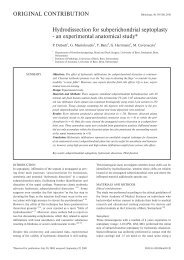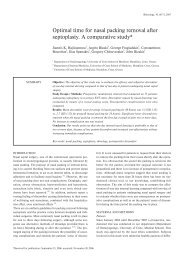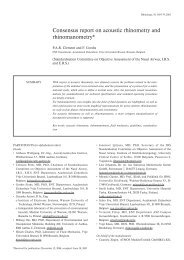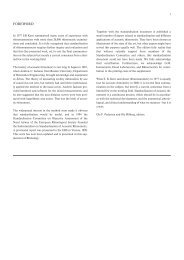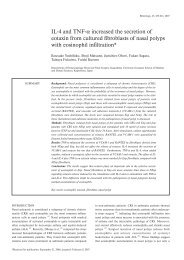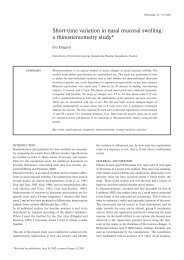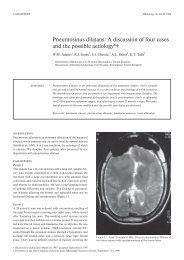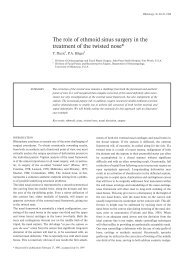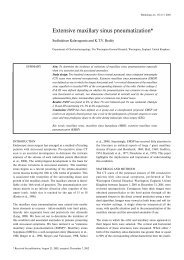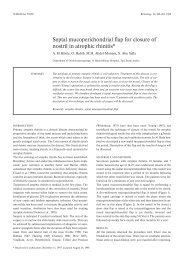The effect of smoking on the olfactory function* - ResearchGate
The effect of smoking on the olfactory function* - ResearchGate
The effect of smoking on the olfactory function* - ResearchGate
Create successful ePaper yourself
Turn your PDF publications into a flip-book with our unique Google optimized e-Paper software.
Rhinology, 45, 273-280, 2007<br />
<str<strong>on</strong>g>The</str<strong>on</strong>g> <str<strong>on</strong>g>effect</str<strong>on</strong>g> <str<strong>on</strong>g>of</str<strong>on</strong>g> <str<strong>on</strong>g>smoking</str<strong>on</strong>g> <strong>on</strong> <strong>the</strong> <strong>olfactory</strong> functi<strong>on</strong>*<br />
Michael Katotomichelakis 1 , Dimitrios Balatsouras 2 , Gregory Tripsianis 3 ,<br />
Spiros Davris 4 , Nikolaos Maroudias 5 , Vassilios Danielides 1 ,<br />
C<strong>on</strong>stantinos Simopoulos 6<br />
1<br />
2<br />
3<br />
4<br />
5<br />
6<br />
Department <str<strong>on</strong>g>of</str<strong>on</strong>g> Otolaryngology, Medical School, Democritus University <str<strong>on</strong>g>of</str<strong>on</strong>g> Thrace, Alexandroupolis, Greece<br />
Department <str<strong>on</strong>g>of</str<strong>on</strong>g> Otolaryngology, Tzani<strong>on</strong> General Hospital <str<strong>on</strong>g>of</str<strong>on</strong>g> Piraeus, Piraeus, Greece<br />
Department <str<strong>on</strong>g>of</str<strong>on</strong>g> Medical Statistics, Medical School, Democritus University <str<strong>on</strong>g>of</str<strong>on</strong>g> Thrace, Alexandroupolis, Greece<br />
Department <str<strong>on</strong>g>of</str<strong>on</strong>g> Otolaryngology, “Errikos Dynan”General Hospital <str<strong>on</strong>g>of</str<strong>on</strong>g> A<strong>the</strong>ns, A<strong>the</strong>ns, Greece<br />
Department <str<strong>on</strong>g>of</str<strong>on</strong>g> Otolaryngology, “Agia Olga” General Hospital <str<strong>on</strong>g>of</str<strong>on</strong>g> A<strong>the</strong>ns, A<strong>the</strong>ns, Greece<br />
Sec<strong>on</strong>d Department <str<strong>on</strong>g>of</str<strong>on</strong>g> Surgery, Medical School, Democritus University <str<strong>on</strong>g>of</str<strong>on</strong>g> Thrace, Alexandroupolis, Greece<br />
SUMMARY<br />
Although <str<strong>on</strong>g>smoking</str<strong>on</strong>g> is a widely spread habit, its <str<strong>on</strong>g>effect</str<strong>on</strong>g> <strong>on</strong> olfacti<strong>on</strong> has not been clearly established.<br />
<str<strong>on</strong>g>The</str<strong>on</strong>g> aim <str<strong>on</strong>g>of</str<strong>on</strong>g> this study was to investigate <strong>the</strong> <str<strong>on</strong>g>effect</str<strong>on</strong>g> <str<strong>on</strong>g>of</str<strong>on</strong>g> cigarette <str<strong>on</strong>g>smoking</str<strong>on</strong>g> <strong>on</strong> <strong>the</strong> <strong>olfactory</strong><br />
functi<strong>on</strong>, using <strong>the</strong> "Sniffin’ Sticks" test. Sixty-five smokers were studied, with a median<br />
period <str<strong>on</strong>g>of</str<strong>on</strong>g> <str<strong>on</strong>g>smoking</str<strong>on</strong>g> <str<strong>on</strong>g>of</str<strong>on</strong>g> 10 years (range: 1–45 years) and a median number <str<strong>on</strong>g>of</str<strong>on</strong>g> 15 cigarettes<br />
smoked per day (range: 5–20). Forty-nine n<strong>on</strong>-smokers were used as c<strong>on</strong>trols. Olfactory functi<strong>on</strong><br />
was evaluated using <strong>the</strong> "Sniffin’ Sticks" test, which c<strong>on</strong>sists <str<strong>on</strong>g>of</str<strong>on</strong>g> odour threshold (OT),<br />
odour discriminati<strong>on</strong> (OD) and odour identificati<strong>on</strong> (OI) and its overall results may be presented<br />
as a composite threshold-discriminati<strong>on</strong>-identificati<strong>on</strong> (TDI) score. Multivariate linear<br />
and logistic regressi<strong>on</strong> analyses were performed. All OT, OD, OI and TDI scores were<br />
statistically significantly lower in smokers compared to n<strong>on</strong>-smokers, even when c<strong>on</strong>trolled<br />
for gender and age. Low OT, OD, OI and TDI scores were more prevalent am<strong>on</strong>g smokers<br />
than n<strong>on</strong>-smokers. Multivariate logistic regressi<strong>on</strong> analysis, adjusted for gender and age,<br />
revealed that <str<strong>on</strong>g>smoking</str<strong>on</strong>g> remained a str<strong>on</strong>g independent risk factor for low OT, OD, OI and<br />
TDI scores. Am<strong>on</strong>g smokers, statistically significant negative relati<strong>on</strong>ships were found<br />
between pack-years and OT, OD, OI and TDI, c<strong>on</strong>trolling for age. In c<strong>on</strong>clusi<strong>on</strong>, <str<strong>on</strong>g>smoking</str<strong>on</strong>g><br />
was found to be adversely associated with <strong>the</strong> <strong>olfactory</strong> ability in a dose-related manner.<br />
Smokers were found to be nearly six times as likely to evidence an <strong>olfactory</strong> deficit as n<strong>on</strong><br />
smokers, depending <strong>on</strong> <strong>the</strong> durati<strong>on</strong> and <strong>the</strong> amount <str<strong>on</strong>g>of</str<strong>on</strong>g> cigarettes smoked.<br />
Key words: olfacti<strong>on</strong>, <strong>olfactory</strong> thresholds, <strong>olfactory</strong> discriminati<strong>on</strong>, <strong>olfactory</strong> identificati<strong>on</strong>,<br />
<str<strong>on</strong>g>smoking</str<strong>on</strong>g>, Sniffin’ Sticks.<br />
INTRODUCTION<br />
Olfactory evaluati<strong>on</strong> has been <str<strong>on</strong>g>of</str<strong>on</strong>g>ten neglected in clinical practice,<br />
despite its importance in <strong>the</strong> otolaryngologic and neurologic<br />
clinical examinati<strong>on</strong>. <str<strong>on</strong>g>The</str<strong>on</strong>g> main reas<strong>on</strong> for this was <strong>the</strong><br />
lack <str<strong>on</strong>g>of</str<strong>on</strong>g> simple, fast and reliable methods <str<strong>on</strong>g>of</str<strong>on</strong>g> <strong>olfactory</strong> testing.<br />
Several <strong>olfactory</strong> tests were introduced during <strong>the</strong> past two<br />
decades, but <strong>on</strong>ly a few <str<strong>on</strong>g>of</str<strong>on</strong>g> <strong>the</strong>m proved successful, including<br />
<strong>the</strong> University <str<strong>on</strong>g>of</str<strong>on</strong>g> Pennsylvania Smell Identificati<strong>on</strong> Test<br />
(UPSIT) (1) with its down-scaled cross-cultural versi<strong>on</strong> (CC-<br />
SIT) (2) and <strong>the</strong> C<strong>on</strong>necticut Chemosensory Clinical Research<br />
Center Test (CCCRC) (3) . Recently, a new <strong>olfactory</strong> test developed<br />
in Germany by Kobal and Hummel (4,5) became commercially<br />
available under <strong>the</strong> name “Sniffin’ Sticks”.<br />
“Sniffin’ Sticks” are odour-dispensing devices that resemble<br />
felt-tip pens. <str<strong>on</strong>g>The</str<strong>on</strong>g> “Sniffin’ Sticks” test battery c<strong>on</strong>sists <str<strong>on</strong>g>of</str<strong>on</strong>g> three<br />
elaborate tests <str<strong>on</strong>g>of</str<strong>on</strong>g> <strong>olfactory</strong> functi<strong>on</strong>: odour threshold (OT),<br />
odour discriminati<strong>on</strong> (OD), and odour identificati<strong>on</strong> (OI) (4,5) .<br />
Presently, this test is widely used in European Clinics.<br />
Previous work has already established its test-retest reliability<br />
and its validity in comparis<strong>on</strong> with established measures <str<strong>on</strong>g>of</str<strong>on</strong>g><br />
<strong>olfactory</strong> sensitivity obtained by <strong>the</strong> UPSIT, <strong>the</strong> CCCRC and<br />
<strong>the</strong> CC-SIT tests (5,6) . In our previous work, we provided normative<br />
values for <strong>olfactory</strong> functi<strong>on</strong> and examined <strong>the</strong> <str<strong>on</strong>g>effect</str<strong>on</strong>g> <str<strong>on</strong>g>of</str<strong>on</strong>g><br />
age, sex, and side tested in <strong>the</strong> populati<strong>on</strong> in Greece, which is<br />
characterized by a mild Mediterranean climate (7) .<br />
*Received for publicati<strong>on</strong>: July 15, 2007; accepted: August 8, 2007
274 Katotomichelakis et al.<br />
<str<strong>on</strong>g>The</str<strong>on</strong>g> <str<strong>on</strong>g>effect</str<strong>on</strong>g> <str<strong>on</strong>g>of</str<strong>on</strong>g> <str<strong>on</strong>g>smoking</str<strong>on</strong>g> <strong>on</strong> <strong>the</strong> <strong>olfactory</strong> funti<strong>on</strong> is an important<br />
issue, which has not been sufficiently investigated (8) , although<br />
adequate evidence exists supporting <strong>the</strong> great influence <str<strong>on</strong>g>of</str<strong>on</strong>g> various<br />
chemical substances <strong>on</strong> <strong>the</strong> <strong>olfactory</strong> functi<strong>on</strong> (9) . Additi<strong>on</strong>ally,<br />
research <strong>on</strong> <strong>the</strong> <str<strong>on</strong>g>effect</str<strong>on</strong>g> <str<strong>on</strong>g>of</str<strong>on</strong>g> <str<strong>on</strong>g>smoking</str<strong>on</strong>g> <strong>on</strong> olfacti<strong>on</strong> has<br />
focused mainly <strong>on</strong> threshold sensitivity, and, practically, no<br />
informati<strong>on</strong> is available about <strong>the</strong> ability <str<strong>on</strong>g>of</str<strong>on</strong>g> smokers to identify<br />
and discriminate odours, questi<strong>on</strong>s <str<strong>on</strong>g>of</str<strong>on</strong>g> a great c<strong>on</strong>cern both in<br />
real life and in <strong>the</strong> clinic (10) . As <str<strong>on</strong>g>smoking</str<strong>on</strong>g> is a worldwide habit<br />
for milli<strong>on</strong>s <str<strong>on</strong>g>of</str<strong>on</strong>g> people, fur<strong>the</strong>r investigati<strong>on</strong> <str<strong>on</strong>g>of</str<strong>on</strong>g> its possible<br />
<str<strong>on</strong>g>effect</str<strong>on</strong>g>s <strong>on</strong> <strong>the</strong> <strong>olfactory</strong> functi<strong>on</strong> is warranted.<br />
<str<strong>on</strong>g>The</str<strong>on</strong>g> aim <str<strong>on</strong>g>of</str<strong>on</strong>g> <strong>the</strong> present study was to determine <strong>the</strong> <str<strong>on</strong>g>effect</str<strong>on</strong>g> <str<strong>on</strong>g>of</str<strong>on</strong>g><br />
<str<strong>on</strong>g>smoking</str<strong>on</strong>g> not <strong>on</strong>ly <strong>on</strong> OT, but also <strong>on</strong> OD and OI in <strong>the</strong> Greek<br />
populati<strong>on</strong>, using <strong>the</strong> “Sniffin’ Sticks” tests. Ano<strong>the</strong>r goal <str<strong>on</strong>g>of</str<strong>on</strong>g> <strong>the</strong><br />
study was to provide <strong>the</strong> risk factor for smokers to manifestate<br />
problems with <strong>the</strong>ir <strong>olfactory</strong> functi<strong>on</strong>, in comparis<strong>on</strong> with n<strong>on</strong>smokers,<br />
according to <strong>the</strong> dose and <strong>the</strong> durati<strong>on</strong> <str<strong>on</strong>g>of</str<strong>on</strong>g> <str<strong>on</strong>g>smoking</str<strong>on</strong>g>.<br />
MATERIALS AND METHODS<br />
Human Subjects<br />
One hundred fourteen healthy volunteers were studied during<br />
<strong>on</strong>e year, from September 2004 to August 2005. Sixty-five <str<strong>on</strong>g>of</str<strong>on</strong>g><br />
<strong>the</strong>m (57%) were smokers and 49 subjects (43%) had never<br />
smoked and did not live with or work with smokers according<br />
to <strong>the</strong> informati<strong>on</strong> <strong>the</strong>y provided. Complete <str<strong>on</strong>g>smoking</str<strong>on</strong>g> histories<br />
were taken from all subjects. All <strong>the</strong> participants were in general<br />
good c<strong>on</strong>diti<strong>on</strong>. <str<strong>on</strong>g>The</str<strong>on</strong>g>re were no abnormal findings from <strong>the</strong><br />
nose and <strong>the</strong> paranasal sinuses, as proven by both nasal<br />
endoscopy and computerized tomography scan <str<strong>on</strong>g>of</str<strong>on</strong>g> <strong>the</strong> regi<strong>on</strong>.<br />
Additi<strong>on</strong>ally, <strong>the</strong>re was no history <str<strong>on</strong>g>of</str<strong>on</strong>g> any major <strong>olfactory</strong> disturbance<br />
in any <str<strong>on</strong>g>of</str<strong>on</strong>g> <strong>the</strong>m. <str<strong>on</strong>g>The</str<strong>on</strong>g> care <str<strong>on</strong>g>of</str<strong>on</strong>g> <strong>the</strong> human subjects for<br />
this study was approved by <strong>the</strong> local Instituti<strong>on</strong>al Review<br />
Board. All subjects were volunteers and were fully explained<br />
<strong>the</strong> aim, <strong>the</strong> design and <strong>the</strong> clinical implicati<strong>on</strong>s <str<strong>on</strong>g>of</str<strong>on</strong>g> <strong>the</strong> study.<br />
<str<strong>on</strong>g>The</str<strong>on</strong>g> investigati<strong>on</strong>s were performed in accordance with <strong>the</strong><br />
principles <str<strong>on</strong>g>of</str<strong>on</strong>g> <strong>the</strong> Declarati<strong>on</strong> <str<strong>on</strong>g>of</str<strong>on</strong>g> Helsinki/H<strong>on</strong>gK<strong>on</strong>g.<br />
Olfactory Testing<br />
Identical <strong>olfactory</strong> tests were performed in a bilateral and a lateralized<br />
mode, using <strong>the</strong> “Sniffin’ Sticks” test package (Burghardt,<br />
Wedel, Germany). <str<strong>on</strong>g>The</str<strong>on</strong>g> sequence <str<strong>on</strong>g>of</str<strong>on</strong>g> testing <strong>the</strong> left, right, or<br />
both nostrils was randomized across all subjects.<br />
Specific tests for OT, OD and OI were performed. <str<strong>on</strong>g>The</str<strong>on</strong>g> OT test<br />
was performed with n-butanol and was evaluated using a singlestaircase,<br />
triple-forced choice procedure (11) . A 1:2 diluti<strong>on</strong> series<br />
with 16 stages, beginning with 4% was used; diluti<strong>on</strong>s were<br />
established in a geometric series, according to previous reports<br />
(12) . In <strong>the</strong> suprathreshold OD test, triplets <str<strong>on</strong>g>of</str<strong>on</strong>g> pens were presented<br />
in a randomized order, with two c<strong>on</strong>taining <strong>the</strong> same odorant<br />
and <strong>the</strong> third a different odorant. <str<strong>on</strong>g>The</str<strong>on</strong>g> examined was asked to<br />
detect which <str<strong>on</strong>g>of</str<strong>on</strong>g> <strong>the</strong> three pens smelled differently from <strong>the</strong><br />
remaining two. For <strong>the</strong> OI test 16 odorants were presented in<br />
suprathreshold intensity. <str<strong>on</strong>g>The</str<strong>on</strong>g> examined was asked to identify<br />
Table 1. Olfactory functi<strong>on</strong> (mean values ± SD) in relati<strong>on</strong> to <str<strong>on</strong>g>smoking</str<strong>on</strong>g>.<br />
Smokers N<strong>on</strong>-smokers p-value 95% CI <str<strong>on</strong>g>of</str<strong>on</strong>g><br />
difference<br />
Odor threshold 7.3 ± 0.9 8.5 ± 0.9 < 0.001 -1.6 to -0.9<br />
Odor discriminati<strong>on</strong> 14.8 ± 0.9 15.7 ± 0.7 < 0.001 -1.2 to -0.6<br />
Odor identificati<strong>on</strong> 14.2 ± 1.0 14.9 ± 0.8 < 0.001 -1.1 to -0.4<br />
Composite (TDI) score 36.3 ± 2.0 39.1 ± 1.6 < 0.001 -3.5 to -2.2<br />
SD: standard deviati<strong>on</strong>; CI : c<strong>on</strong>fidence interval.<br />
individual odorants from a list <str<strong>on</strong>g>of</str<strong>on</strong>g> four descriptors, using a multiple-choice<br />
procedure. In all three tests, subjects were blindfolded<br />
to avoid visual identificati<strong>on</strong> <str<strong>on</strong>g>of</str<strong>on</strong>g> <strong>the</strong> odorant-c<strong>on</strong>taining pens,<br />
and <strong>the</strong> obtained score was an integral, ranging from 0 (no odorant<br />
recognized) to 16 (all odorants recognized).<br />
Finally, according to <strong>the</strong> principles <str<strong>on</strong>g>of</str<strong>on</strong>g> previous reports (6,13) ,<strong>the</strong><br />
results <str<strong>on</strong>g>of</str<strong>on</strong>g> <strong>the</strong> three tests were combined to form an overall<br />
score called “composite threshold-discriminati<strong>on</strong>-identificati<strong>on</strong><br />
score” (TDI). TDI represented <strong>the</strong> sum <str<strong>on</strong>g>of</str<strong>on</strong>g> <strong>the</strong> results obtained<br />
for OT, OD and OI tests and might prove useful in daily clinical<br />
practice as a single indicator <str<strong>on</strong>g>of</str<strong>on</strong>g> <strong>olfactory</strong> performance. <str<strong>on</strong>g>The</str<strong>on</strong>g><br />
TDI score ranged from 0 to 48, with values ≤ 15 c<strong>on</strong>sidered<br />
c<strong>on</strong>sistent with anosmia, because <str<strong>on</strong>g>of</str<strong>on</strong>g> <strong>the</strong> probability <str<strong>on</strong>g>of</str<strong>on</strong>g> obtaining<br />
this number <str<strong>on</strong>g>of</str<strong>on</strong>g> correct results by chance al<strong>on</strong>e (4,14) .<br />
All subjects completed <strong>the</strong> test. <str<strong>on</strong>g>The</str<strong>on</strong>g> time needed for <strong>the</strong> complete<br />
examinati<strong>on</strong> ranged from 20 to 30 min. <str<strong>on</strong>g>The</str<strong>on</strong>g>ir scores for<br />
OT, OD and OI tasks were related to age and sex. Cigarette dose<br />
was calculated in pack-years by multiplying <strong>the</strong> number <str<strong>on</strong>g>of</str<strong>on</strong>g> packs<br />
smoked per day by <strong>the</strong> number <str<strong>on</strong>g>of</str<strong>on</strong>g> years that <str<strong>on</strong>g>smoking</str<strong>on</strong>g> occurred.<br />
Statistics<br />
Statistical analysis <str<strong>on</strong>g>of</str<strong>on</strong>g> <strong>the</strong> data was performed using <strong>the</strong> Statistical<br />
Package for <strong>the</strong> Social Sciences (SPSS), versi<strong>on</strong> 13.0 (SPSS, Inc.,<br />
Chicago, IL). <str<strong>on</strong>g>The</str<strong>on</strong>g> normality <str<strong>on</strong>g>of</str<strong>on</strong>g> c<strong>on</strong>tinuous variables was tested<br />
with <strong>the</strong> Kolmogorov-Smirnov test. Normally distributed c<strong>on</strong>tinuous<br />
variables were expressed as <strong>the</strong> mean ± SD (standard deviati<strong>on</strong>),<br />
while n<strong>on</strong>-normally distributed variables were expressed<br />
as <strong>the</strong> median and range. Categorical variables were expressed as<br />
frequencies (and percentages). <str<strong>on</strong>g>The</str<strong>on</strong>g> chi-square test was used to<br />
evaluate any potential associati<strong>on</strong> between categorical variables.<br />
Student’s t-test was used to assess differences <str<strong>on</strong>g>of</str<strong>on</strong>g> indices <str<strong>on</strong>g>of</str<strong>on</strong>g> <strong>olfactory</strong><br />
functi<strong>on</strong> between smokers and n<strong>on</strong>-smokers. Multivariate<br />
stepwise linear and logistic regressi<strong>on</strong> models were c<strong>on</strong>structed<br />
to explore <strong>the</strong> independent <str<strong>on</strong>g>effect</str<strong>on</strong>g> <str<strong>on</strong>g>of</str<strong>on</strong>g> <str<strong>on</strong>g>smoking</str<strong>on</strong>g> <strong>on</strong> <strong>the</strong> indices <str<strong>on</strong>g>of</str<strong>on</strong>g><br />
<strong>olfactory</strong> functi<strong>on</strong>. Subject’s gender and age were <strong>the</strong> major c<strong>on</strong>founders<br />
in all multivariate models. Adjusted odd ratios (aOR)<br />
and 95% c<strong>on</strong>fidence intervals (CI) were estimated as <strong>the</strong> measure<br />
<str<strong>on</strong>g>of</str<strong>on</strong>g> associati<strong>on</strong> between <str<strong>on</strong>g>smoking</str<strong>on</strong>g> and <strong>the</strong> presence <str<strong>on</strong>g>of</str<strong>on</strong>g> <strong>olfactory</strong><br />
dysfuncti<strong>on</strong>. Pears<strong>on</strong>’s r-correlati<strong>on</strong> coefficient was used to<br />
assess <strong>the</strong> relati<strong>on</strong> between pack-years and <strong>the</strong> indices <str<strong>on</strong>g>of</str<strong>on</strong>g> <strong>olfactory</strong><br />
functi<strong>on</strong>. All tests were two-tailed and statistical significance<br />
was accepted at <strong>the</strong> p < 0.05 level.
Smoking and olfacti<strong>on</strong> 275<br />
45<br />
40<br />
35<br />
Smokers<br />
N<strong>on</strong>-smokers<br />
p
276 Katotomichelakis et al.<br />
Table 3. Associati<strong>on</strong> between <str<strong>on</strong>g>smoking</str<strong>on</strong>g> and <strong>the</strong> presence <str<strong>on</strong>g>of</str<strong>on</strong>g> <strong>olfactory</strong> dysfuncti<strong>on</strong> (lower than <strong>the</strong> 10th percentile <str<strong>on</strong>g>of</str<strong>on</strong>g> <strong>the</strong> reference values) expressed as<br />
odds ratios with 95% c<strong>on</strong>fidence intervals.<br />
Smokers* N<strong>on</strong>-smokers* aOR (95% CI) p-value<br />
Odor threshold 32 (49.2) 8 (16.3) 3.0 (1.0-7.7) 0.040<br />
Odor discriminati<strong>on</strong> 24 (36.9) 5 (10.2) 3.4 (1.1-11.3) 0.044<br />
Odor identificati<strong>on</strong> 20 (30.8) 3 (6.1) 5.0 (1.1-23.7) 0.041<br />
Composite (TDI) score 16 (24.6) 3 (6.1) 5.9 (1.2-28.9) 0.026<br />
* Data are number <str<strong>on</strong>g>of</str<strong>on</strong>g> cases; percentages are shown in paren<strong>the</strong>ses; aOR: adjusted odds ratio for gender and age; CI: c<strong>on</strong>fidence interval.<br />
results <str<strong>on</strong>g>of</str<strong>on</strong>g> studies from o<strong>the</strong>r settings using <strong>the</strong> same <strong>olfactory</strong><br />
test (4,5) . In particular, <strong>the</strong> cut-<str<strong>on</strong>g>of</str<strong>on</strong>g>f for OT score was 7, for OD<br />
score it was 14, for OI score it was 13 and for TDI score it was<br />
34.50. Low OT, OD, OI and TDI scores were more prevalent<br />
am<strong>on</strong>g smokers compared to n<strong>on</strong>-smokers (OT: 49.2% versus<br />
16.3%, p < 0.001; OD: 36.9% versus 10.2%, p = 0.001; OI: 30.8%<br />
versus 6.1%, p = 0.001; TDI: 24.6% versus 6.1%, p = 0.009).<br />
Multivariate logistic regressi<strong>on</strong> analysis, adjusted for gender<br />
and age (Table 3), revealed that <str<strong>on</strong>g>smoking</str<strong>on</strong>g> remained a str<strong>on</strong>g<br />
independent significant predictor <str<strong>on</strong>g>of</str<strong>on</strong>g> low OT, OD, OI and TDI<br />
scores (OT: aOR = 3.0, 95% CI = 1.0–7.7, p = 0.040; OD: aOR<br />
= 3.4, 95% CI = 1.1–11.3, p = 0.044; OI: aOR = 5.0, 95% CI =<br />
1.1–23.7, p = 0.041; TDI: aOR = 5.9, 95% CI = 1.2–28.9,<br />
p = 0.026).<br />
Based <strong>on</strong> <strong>the</strong> number <str<strong>on</strong>g>of</str<strong>on</strong>g> packs smoked per day and <strong>the</strong> number<br />
<str<strong>on</strong>g>of</str<strong>on</strong>g> years that <str<strong>on</strong>g>smoking</str<strong>on</strong>g> occurred, <strong>the</strong> number <str<strong>on</strong>g>of</str<strong>on</strong>g> pack-years was<br />
calculated for each smoker. <str<strong>on</strong>g>The</str<strong>on</strong>g> median number <str<strong>on</strong>g>of</str<strong>on</strong>g> pack-years<br />
was 15 (range 0.5–45.0). Am<strong>on</strong>g <strong>the</strong> smokers <str<strong>on</strong>g>of</str<strong>on</strong>g> our study, statistically<br />
significant negative relati<strong>on</strong>ships were found between<br />
pack-years and OT (r = –0.544, p
Smoking and olfacti<strong>on</strong> 277<br />
and passive smokers in butanol and pyridin, and reported that<br />
smokers are less sensitive to <strong>the</strong> odours <str<strong>on</strong>g>of</str<strong>on</strong>g> both substances<br />
than are n<strong>on</strong>smokers. Additi<strong>on</strong>ally, <strong>the</strong>y found that <strong>the</strong> scores<br />
obtained from passive smokers were similar to those <str<strong>on</strong>g>of</str<strong>on</strong>g> <strong>the</strong><br />
smokers. <str<strong>on</strong>g>The</str<strong>on</strong>g> authors discussed <strong>the</strong> possibility <str<strong>on</strong>g>of</str<strong>on</strong>g> habituati<strong>on</strong><br />
to <strong>the</strong> odour, which a central phenomen<strong>on</strong> and refers to <strong>the</strong><br />
cessati<strong>on</strong> <str<strong>on</strong>g>of</str<strong>on</strong>g> a resp<strong>on</strong>se because <str<strong>on</strong>g>of</str<strong>on</strong>g> a learned adjustment to a<br />
stimulus situati<strong>on</strong>. However, in our study, although we did not<br />
include passive smokers, we found a clear decrease in OT, OD<br />
and OI ability <str<strong>on</strong>g>of</str<strong>on</strong>g> smokers as related to n<strong>on</strong>-smokers. Especially<br />
<strong>the</strong> OT ability in smokers presented a 14.1% reducti<strong>on</strong>, while<br />
5.7% and 4.7% reducti<strong>on</strong>s were observed in OD and OI tests,<br />
respectively. <str<strong>on</strong>g>The</str<strong>on</strong>g>refore, it appears that smokers smell substances<br />
in higher c<strong>on</strong>centrati<strong>on</strong>s than <strong>the</strong> n<strong>on</strong>-smokers and<br />
<strong>the</strong>y discriminate and identify odours with more difficulty than<br />
subjects who d<strong>on</strong>’t smoke. This should be attributed to an<br />
<strong>olfactory</strong> deficit ra<strong>the</strong>r than habituati<strong>on</strong>, because testing<br />
included a wide range <str<strong>on</strong>g>of</str<strong>on</strong>g> odours and besides threshold sensitivity,<br />
OD and OI were examined as well.<br />
In ano<strong>the</strong>r study (8) , a large group <str<strong>on</strong>g>of</str<strong>on</strong>g> subjects was divided into<br />
n<strong>on</strong>-smokers, subjects who had smoked in <strong>the</strong> past and in current<br />
smokers. <str<strong>on</strong>g>The</str<strong>on</strong>g> authors found a clear adverse <str<strong>on</strong>g>effect</str<strong>on</strong>g> <str<strong>on</strong>g>of</str<strong>on</strong>g> cigarette<br />
<str<strong>on</strong>g>smoking</str<strong>on</strong>g> <strong>on</strong> <strong>olfactory</strong> functi<strong>on</strong> that is dose related and<br />
present in past smokers. An interesting point was that this<br />
<str<strong>on</strong>g>effect</str<strong>on</strong>g> was reversible, with <strong>the</strong> time course <str<strong>on</strong>g>of</str<strong>on</strong>g> its reversibility<br />
being dependent <strong>on</strong> <strong>the</strong> durati<strong>on</strong> <str<strong>on</strong>g>of</str<strong>on</strong>g> abstinence from <str<strong>on</strong>g>smoking</str<strong>on</strong>g><br />
and <strong>the</strong> intensity <str<strong>on</strong>g>of</str<strong>on</strong>g> prior <str<strong>on</strong>g>smoking</str<strong>on</strong>g> activity. According to <strong>the</strong><br />
authors, <strong>the</strong> finding that past smokers evidence dose-related<br />
decrements in <strong>the</strong>ir OI ability similar with those observed in<br />
current smokers, may explain discrepancies observed in previous<br />
studies that examined <strong>the</strong> <str<strong>on</strong>g>effect</str<strong>on</strong>g> <str<strong>on</strong>g>of</str<strong>on</strong>g> <str<strong>on</strong>g>smoking</str<strong>on</strong>g> <strong>on</strong> olfacti<strong>on</strong>.<br />
Such studies categorized past smokers as n<strong>on</strong>-smokers and,<br />
additi<strong>on</strong>ally, did not c<strong>on</strong>trol for <strong>the</strong> <str<strong>on</strong>g>effect</str<strong>on</strong>g>s <str<strong>on</strong>g>of</str<strong>on</strong>g> cumulative<br />
10<br />
9<br />
A<br />
17,0<br />
16,0<br />
B<br />
Odor threshold score<br />
8<br />
7<br />
6<br />
Odor discriminati<strong>on</strong> score<br />
15,0<br />
14,0<br />
5<br />
r= -0.54 4<br />
13,0<br />
r= -0.5 01<br />
p
278 Katotomichelakis et al.<br />
<str<strong>on</strong>g>smoking</str<strong>on</strong>g> dose. Additi<strong>on</strong>ally, Murphy et al. (28) studied high risk<br />
factors for <strong>olfactory</strong> impairment in a large group <str<strong>on</strong>g>of</str<strong>on</strong>g> older adults<br />
and <strong>the</strong>y found that <strong>on</strong>ly current <str<strong>on</strong>g>smoking</str<strong>on</strong>g> was associated with<br />
impaired olfacti<strong>on</strong>. <str<strong>on</strong>g>The</str<strong>on</strong>g>y did not find any significant difference<br />
between pers<strong>on</strong>s who had never smoked and past smokers,<br />
implicating reversible <str<strong>on</strong>g>effect</str<strong>on</strong>g>s <str<strong>on</strong>g>of</str<strong>on</strong>g> tobacco <strong>on</strong> <strong>the</strong> <strong>olfactory</strong> functi<strong>on</strong>.<br />
On <strong>the</strong> c<strong>on</strong>trary, in a recent study <str<strong>on</strong>g>of</str<strong>on</strong>g> odour identificati<strong>on</strong><br />
in a Japanese adult populati<strong>on</strong> (29) , <strong>the</strong> authors found decreased<br />
odour identificati<strong>on</strong> to both current and past smokers. <str<strong>on</strong>g>The</str<strong>on</strong>g>y<br />
c<strong>on</strong>cluded that cessati<strong>on</strong> <str<strong>on</strong>g>of</str<strong>on</strong>g> <str<strong>on</strong>g>smoking</str<strong>on</strong>g> may not provide recovery<br />
<str<strong>on</strong>g>of</str<strong>on</strong>g> <strong>olfactory</strong> functi<strong>on</strong> and attributed <strong>the</strong> discrepancies <str<strong>on</strong>g>of</str<strong>on</strong>g> <strong>the</strong>ir<br />
findings with previous reports to <strong>the</strong> different ethnicity <str<strong>on</strong>g>of</str<strong>on</strong>g> <strong>the</strong><br />
sample studied and to <strong>the</strong> use <str<strong>on</strong>g>of</str<strong>on</strong>g> CC-SIT as an odour identificati<strong>on</strong><br />
test, which might have lower sensitivity than <strong>the</strong> standard<br />
UPSIT.<br />
To avoid this c<strong>on</strong>fusing factor, we excluded past-smokers and<br />
we calculated cigarette dose in pack-years. We, thus, c<strong>on</strong>firmed<br />
that <strong>the</strong> adverse <str<strong>on</strong>g>effect</str<strong>on</strong>g> <str<strong>on</strong>g>of</str<strong>on</strong>g> cigarette <str<strong>on</strong>g>smoking</str<strong>on</strong>g> <strong>on</strong> <strong>olfactory</strong> functi<strong>on</strong><br />
is dose and durati<strong>on</strong> related. A statistically significant negative<br />
relati<strong>on</strong> was found between pack per years and all olfacti<strong>on</strong><br />
measures, even after c<strong>on</strong>trolling for age. Thus, it may be<br />
c<strong>on</strong>cluded that both cigarette <str<strong>on</strong>g>smoking</str<strong>on</strong>g> per se and <strong>the</strong> actual<br />
amount <str<strong>on</strong>g>of</str<strong>on</strong>g> cigarettes smoked can be directly correlated with a<br />
diminished <strong>olfactory</strong> acuity as measured by this test procedure.<br />
Age <str<strong>on</strong>g>of</str<strong>on</strong>g> <strong>the</strong> subject and sex did not interact with <str<strong>on</strong>g>smoking</str<strong>on</strong>g> dose,<br />
indicating that age and sex did not potentiate or attenuate <strong>the</strong><br />
<str<strong>on</strong>g>smoking</str<strong>on</strong>g> dose <str<strong>on</strong>g>effect</str<strong>on</strong>g>.<br />
Smoking may have a negative impact in olfacti<strong>on</strong> in patients<br />
with sinusitis and polyposis, operated by endoscopic sinus<br />
surgery. Sugiyama et al. (30,31) found that <strong>the</strong>re was a significant<br />
negative correlati<strong>on</strong> between <strong>the</strong> cumulative dose <str<strong>on</strong>g>of</str<strong>on</strong>g> cigarette<br />
<str<strong>on</strong>g>smoking</str<strong>on</strong>g> and <strong>the</strong> postoperative olfacti<strong>on</strong> measures. Smokinginduced<br />
<strong>olfactory</strong> dysfuncti<strong>on</strong> might be <strong>the</strong> result <str<strong>on</strong>g>of</str<strong>on</strong>g> not <strong>on</strong>ly<br />
cigarette <str<strong>on</strong>g>smoking</str<strong>on</strong>g> per se but also <strong>the</strong> interactive <str<strong>on</strong>g>effect</str<strong>on</strong>g> <str<strong>on</strong>g>of</str<strong>on</strong>g> aging<br />
and <str<strong>on</strong>g>smoking</str<strong>on</strong>g>, because <strong>the</strong> deficit in olfacti<strong>on</strong> was observed<br />
<strong>on</strong>ly in older smokers. <str<strong>on</strong>g>The</str<strong>on</strong>g> authors hypo<strong>the</strong>sized that cigarette<br />
<str<strong>on</strong>g>smoking</str<strong>on</strong>g> may cause time-related alterati<strong>on</strong>s in <strong>the</strong> <strong>olfactory</strong><br />
system via its l<strong>on</strong>g-standing intranasal neurotoxicity, inducing<br />
dysfuncti<strong>on</strong> <str<strong>on</strong>g>of</str<strong>on</strong>g> <strong>olfactory</strong> receptor cells and thus, reducing <strong>the</strong><br />
ability to smell for older patients.<br />
Recently, in a study <str<strong>on</strong>g>of</str<strong>on</strong>g> <strong>olfactory</strong> dysfuncti<strong>on</strong> in an adult<br />
Swedish populati<strong>on</strong> (32) no increased risk for current smokers<br />
or number <str<strong>on</strong>g>of</str<strong>on</strong>g> pack-years (including both current and past<br />
smokers) was found. <str<strong>on</strong>g>The</str<strong>on</strong>g> authors explained <strong>the</strong>ir findings,<br />
which differ from o<strong>the</strong>r studies and from <strong>the</strong> present <strong>on</strong>e, by<br />
<strong>the</strong> fact that <strong>the</strong>re is a substance-specific <str<strong>on</strong>g>effect</str<strong>on</strong>g> attributable to<br />
overexposure to substances in tobacco smoke. It may be thus<br />
possible, that <str<strong>on</strong>g>smoking</str<strong>on</strong>g> affects olfacti<strong>on</strong> <str<strong>on</strong>g>of</str<strong>on</strong>g> certain substances<br />
more than o<strong>the</strong>rs, and hence, <strong>the</strong> results <str<strong>on</strong>g>of</str<strong>on</strong>g> various studies<br />
may depend <strong>on</strong> <strong>the</strong> type and <strong>the</strong> number <str<strong>on</strong>g>of</str<strong>on</strong>g> tested substances.<br />
This hypo<strong>the</strong>sis is fur<strong>the</strong>r supported by M<strong>on</strong>crieff who reported<br />
that <strong>the</strong> <str<strong>on</strong>g>effect</str<strong>on</strong>g> <str<strong>on</strong>g>of</str<strong>on</strong>g> <str<strong>on</strong>g>smoking</str<strong>on</strong>g> <strong>on</strong> odour percepti<strong>on</strong> is selective,<br />
affecting <strong>on</strong>ly <strong>the</strong> odours <str<strong>on</strong>g>of</str<strong>on</strong>g> substances c<strong>on</strong>tained in tobacco<br />
smoke, such as pyridine, but no o<strong>the</strong>r odors (18) .<br />
In <strong>the</strong> present study, we examined <strong>the</strong> associati<strong>on</strong> between<br />
<str<strong>on</strong>g>smoking</str<strong>on</strong>g> and <strong>the</strong> presence <str<strong>on</strong>g>of</str<strong>on</strong>g> <strong>olfactory</strong> dysfuncti<strong>on</strong> (lower than<br />
<strong>the</strong> 10 th percentile <str<strong>on</strong>g>of</str<strong>on</strong>g> <strong>the</strong> reference values), and we found that<br />
am<strong>on</strong>g n<strong>on</strong>-smokers OT ability is affected easier than OD and<br />
OI, possibly as a result <str<strong>on</strong>g>of</str<strong>on</strong>g> <strong>the</strong> envir<strong>on</strong>mental influence. <str<strong>on</strong>g>The</str<strong>on</strong>g><br />
results <str<strong>on</strong>g>of</str<strong>on</strong>g> <strong>the</strong> logistic regressi<strong>on</strong> analysis revealed that pers<strong>on</strong>s<br />
who currently smoke are nearly six times more likely to have<br />
an <strong>olfactory</strong> deficit in comparis<strong>on</strong> with pers<strong>on</strong>s who have<br />
never smoked (adjusted <str<strong>on</strong>g>smoking</str<strong>on</strong>g> odds ratio [95% c<strong>on</strong>fidence<br />
interval] = 5.9 [1.2-28.9]), as we can see from <strong>the</strong> TDI score.<br />
Moreover, smokers’ normal ability to identify <strong>the</strong> odors is<br />
affected more than <strong>the</strong> OT and OD ability. In <strong>the</strong> present study<br />
we found a 5-fold higher independent risk for dysfuncti<strong>on</strong> <str<strong>on</strong>g>of</str<strong>on</strong>g><br />
<strong>the</strong>ir identificati<strong>on</strong> ability am<strong>on</strong>g smokers compared to n<strong>on</strong>smokers.<br />
Smoking was also associated with 3 and 3.4-fold higher<br />
risk for developing low OT and OD, respectively. It should<br />
be noted that although <strong>olfactory</strong> impairment was much more<br />
prevalent am<strong>on</strong>g smokers, <strong>the</strong> magnitude <str<strong>on</strong>g>of</str<strong>on</strong>g> <strong>the</strong> adverse <str<strong>on</strong>g>effect</str<strong>on</strong>g><br />
<str<strong>on</strong>g>of</str<strong>on</strong>g> <str<strong>on</strong>g>smoking</str<strong>on</strong>g> <strong>on</strong> <strong>olfactory</strong> functi<strong>on</strong> was not large, although statistically<br />
significant. This finding is in agreement with <strong>the</strong> previous<br />
study <str<strong>on</strong>g>of</str<strong>on</strong>g> Frey et al. (8) , in which <strong>the</strong> authors reported <strong>on</strong>ly<br />
mild or moderate and not severe <strong>olfactory</strong> loss from <str<strong>on</strong>g>smoking</str<strong>on</strong>g>.<br />
Table 2 presents our results <str<strong>on</strong>g>of</str<strong>on</strong>g> multivariate linear regressi<strong>on</strong><br />
analysis <str<strong>on</strong>g>of</str<strong>on</strong>g> <strong>olfactory</strong> functi<strong>on</strong> that may be analyzed to deduce<br />
ma<strong>the</strong>matically <strong>the</strong> relati<strong>on</strong>ship between <str<strong>on</strong>g>smoking</str<strong>on</strong>g>, age, gender<br />
and <strong>the</strong>ir OT, OI and OD ability. According to <strong>the</strong>se findings,<br />
<strong>the</strong> relati<strong>on</strong>ship given above does form <strong>the</strong> basis for <strong>the</strong> following<br />
models for <strong>olfactory</strong> functi<strong>on</strong>:<br />
OT = 8.782 − 0.698 Gender − 0.760 Age − 0.740 Smoking;<br />
OD = 15.762 − 0.669 Age − 0.705 Smoking;<br />
OI = 15.049 − 1.277 Age − 0.447 Smoking;<br />
TDI = 39.668 − 0.962 Gender − 2.702 Age − 1.774 Smoking.<br />
<str<strong>on</strong>g>The</str<strong>on</strong>g> primary finding <str<strong>on</strong>g>of</str<strong>on</strong>g> this study that cigarette <str<strong>on</strong>g>smoking</str<strong>on</strong>g><br />
adversely influences <strong>olfactory</strong> ability, expressed from <strong>the</strong> TDI<br />
score, in a dose-durati<strong>on</strong> related manner suggests that <str<strong>on</strong>g>smoking</str<strong>on</strong>g><br />
causes l<strong>on</strong>g-term changes in <strong>the</strong> <strong>olfactory</strong> system. <str<strong>on</strong>g>The</str<strong>on</strong>g> biological<br />
basis for <strong>the</strong> decreased ability to smell associated with<br />
<str<strong>on</strong>g>smoking</str<strong>on</strong>g> is not clear. Irritati<strong>on</strong> or trigeminal stimulati<strong>on</strong> from<br />
exposure to smoke may inhibit activati<strong>on</strong> <str<strong>on</strong>g>of</str<strong>on</strong>g> <strong>the</strong> <strong>olfactory</strong><br />
nerve and c<strong>on</strong>sequently, odour percepti<strong>on</strong> (10) . However; a<br />
direct <str<strong>on</strong>g>effect</str<strong>on</strong>g> <str<strong>on</strong>g>of</str<strong>on</strong>g> tobacco <strong>on</strong> <strong>the</strong> <strong>olfactory</strong> epi<strong>the</strong>lium may be<br />
implicated, as has been proven by several animal studies. It has<br />
been shown that relatively brief exposures to cigarette smoke<br />
in mice (<strong>on</strong>ce or twice per day for 6 to 9 days) can cause<br />
anatomic changes <str<strong>on</strong>g>of</str<strong>on</strong>g> <strong>the</strong> <strong>olfactory</strong> mucosa, including a reducti<strong>on</strong><br />
in <strong>the</strong> number and size <str<strong>on</strong>g>of</str<strong>on</strong>g> <strong>olfactory</strong> vessels and cilia (33) .
Smoking and olfacti<strong>on</strong> 279<br />
Additi<strong>on</strong>ally, it has been found that animals exposed to a<br />
number <str<strong>on</strong>g>of</str<strong>on</strong>g> chemicals present in cigarette smoke dem<strong>on</strong>strate<br />
damage to <strong>the</strong> <strong>olfactory</strong> mucosa and receptor cells, <str<strong>on</strong>g>of</str<strong>on</strong>g>ten in a<br />
dose related manner (34-35) . Exposure to <strong>the</strong> heat and toxic byproducts<br />
<str<strong>on</strong>g>of</str<strong>on</strong>g> tobacco smoke are presumed to damage <strong>the</strong> <strong>olfactory</strong><br />
epi<strong>the</strong>lium in a similar manner to that seen in <strong>the</strong> respiratory<br />
epi<strong>the</strong>lium <str<strong>on</strong>g>of</str<strong>on</strong>g> <strong>the</strong> sinuses and lungs (36) . A recent study in<br />
rats exposed in ethanol and tobacco revealed increase in respiratory<br />
nasal epi<strong>the</strong>lium and decrease in <strong>olfactory</strong> epi<strong>the</strong>lium,<br />
which was thinner, in comparis<strong>on</strong> with <strong>the</strong> c<strong>on</strong>trol group (37) .<br />
Accordingly, l<strong>on</strong>g-term <str<strong>on</strong>g>effect</str<strong>on</strong>g>s <str<strong>on</strong>g>of</str<strong>on</strong>g> <str<strong>on</strong>g>smoking</str<strong>on</strong>g> <strong>on</strong> olfacti<strong>on</strong> could<br />
be caused by <strong>the</strong> adverse influence <str<strong>on</strong>g>of</str<strong>on</strong>g> <strong>the</strong> chemicals c<strong>on</strong>tained<br />
in cigarette smoke <strong>on</strong> <strong>the</strong> <strong>olfactory</strong> receptor cells within <strong>the</strong><br />
<strong>olfactory</strong> mucosa (8) . However, <strong>the</strong> influence <str<strong>on</strong>g>of</str<strong>on</strong>g> such chemicals<br />
might cause short-term <str<strong>on</strong>g>effect</str<strong>on</strong>g>s as well, owed to change <str<strong>on</strong>g>of</str<strong>on</strong>g> <strong>the</strong><br />
c<strong>on</strong>sistency or nature <str<strong>on</strong>g>of</str<strong>on</strong>g> <strong>the</strong> mucus overlying <strong>the</strong> receptors,<br />
and, possibly, adaptati<strong>on</strong> or habituati<strong>on</strong> <str<strong>on</strong>g>of</str<strong>on</strong>g> <strong>the</strong> receptor system.<br />
Nasal airway c<strong>on</strong>stricti<strong>on</strong> might be also implicated, especially<br />
when c<strong>on</strong>siderable airway obstructi<strong>on</strong> is present (38,39) .<br />
<str<strong>on</strong>g>The</str<strong>on</strong>g> role <str<strong>on</strong>g>of</str<strong>on</strong>g> apoptosis, <strong>the</strong> cellular mechanism that is resp<strong>on</strong>sible<br />
for <strong>the</strong> efficient removal <str<strong>on</strong>g>of</str<strong>on</strong>g> aged or damaged cells and may<br />
be triggered in resp<strong>on</strong>se to injury, has been recently studied in<br />
<strong>the</strong> <strong>olfactory</strong> epi<strong>the</strong>lium (40) . This mechanism is predominant<br />
in <strong>olfactory</strong> sensory neur<strong>on</strong>s, replacing dead cells throughout<br />
adult life by mitosis and maturati<strong>on</strong> <str<strong>on</strong>g>of</str<strong>on</strong>g> progenitors present<br />
within <strong>the</strong> epi<strong>the</strong>lium. Several studies have dem<strong>on</strong>strated<br />
apparent increase in <strong>olfactory</strong> sensory neur<strong>on</strong> apoptosis in<br />
sinusitis and aging, but also in animals exposed in tobacco<br />
smoke (40) . Neur<strong>on</strong>al apoptosis is mediated through <strong>the</strong> <str<strong>on</strong>g>effect</str<strong>on</strong>g>or<br />
enzyme caspase-3, which shows increased activity in <strong>the</strong> <strong>olfactory</strong><br />
epi<strong>the</strong>lium <str<strong>on</strong>g>of</str<strong>on</strong>g> tobacco exposed animals, reflecting apoptotic<br />
cell death <str<strong>on</strong>g>of</str<strong>on</strong>g> <strong>the</strong> <strong>olfactory</strong> neur<strong>on</strong>s (41) . This has been suggested<br />
as a comm<strong>on</strong> cause for clinical smell loss.<br />
In c<strong>on</strong>clusi<strong>on</strong>, a diminished <strong>olfactory</strong> sensitivity associated with<br />
cigarette <str<strong>on</strong>g>smoking</str<strong>on</strong>g> was observed, and a direct negative correlati<strong>on</strong><br />
between <strong>olfactory</strong> sensitivity and amount smoked was dem<strong>on</strong>strated.<br />
<str<strong>on</strong>g>The</str<strong>on</strong>g> present findings imply l<strong>on</strong>g-term general <str<strong>on</strong>g>effect</str<strong>on</strong>g>s <str<strong>on</strong>g>of</str<strong>on</strong>g><br />
cigarette <str<strong>on</strong>g>smoking</str<strong>on</strong>g> <strong>on</strong> smell functi<strong>on</strong> and could be explained by<br />
<strong>the</strong> adverse <str<strong>on</strong>g>effect</str<strong>on</strong>g>s <str<strong>on</strong>g>of</str<strong>on</strong>g> airborne chemicals <strong>on</strong> <strong>the</strong> <strong>olfactory</strong> receptors,<br />
resulting in alterati<strong>on</strong>s <str<strong>on</strong>g>of</str<strong>on</strong>g> <strong>the</strong> <strong>olfactory</strong> epi<strong>the</strong>lium and<br />
increased apoptosis <str<strong>on</strong>g>of</str<strong>on</strong>g> <strong>the</strong> <strong>olfactory</strong> sensory neur<strong>on</strong>s.<br />
REFERENCES<br />
1. Doty RL, Shaman P, Kimmelman CP, Dann MS. University <str<strong>on</strong>g>of</str<strong>on</strong>g><br />
Pennsylvania Smell Identificati<strong>on</strong> Test: a rapid quantitative <strong>olfactory</strong><br />
functi<strong>on</strong> test for <strong>the</strong> clinic. Laryngoscope 1984; 94: 176-178.<br />
2. Doty RL, Marcus A, Lee WW. Development <str<strong>on</strong>g>of</str<strong>on</strong>g> <strong>the</strong> 12-item crosscultural<br />
smell identificati<strong>on</strong> test (CC-SIT). Laryngoscope 1996;<br />
106: 353-356.<br />
3. Cain WS, Gent JF, Goodspeed RB, Le<strong>on</strong>ard G. Evaluati<strong>on</strong> <str<strong>on</strong>g>of</str<strong>on</strong>g><br />
<strong>olfactory</strong> dysfuncti<strong>on</strong> in <strong>the</strong> C<strong>on</strong>necticut Chemosensory Clinical<br />
Research Center (CCCRC). Laryngoscope 1988; 98: 83-88.<br />
4. Kobal G, Hummel T, Sekinger B, et al. “Sniffin’Sticks”: screening<br />
<str<strong>on</strong>g>of</str<strong>on</strong>g> <strong>olfactory</strong> performance. Rhinology 1996; 34: 222-226.<br />
5. Hummel T, Sekinger B, Wolf SR, et al. “Sniffin’Sticks”: <strong>olfactory</strong><br />
performance assessed by <strong>the</strong> combined testing <str<strong>on</strong>g>of</str<strong>on</strong>g> odor identificati<strong>on</strong>,<br />
odor discriminati<strong>on</strong>, and <strong>olfactory</strong> thresholds. Chem Senses<br />
1997; 22: 39-52.<br />
6. Wolfensberger M, Schnieper I, Welge-Lussen A. Sniffin’ Sticks: a<br />
new <strong>olfactory</strong> test battery. Acta Otolaryngol. 2000; 120: 303-306.<br />
7. Katotomichelakis M, Balatsouras D, Tripsianis G, Tsaroucha A,<br />
Homsioglou E, Danielides V. Normative values <str<strong>on</strong>g>of</str<strong>on</strong>g> <strong>olfactory</strong> functi<strong>on</strong><br />
testing, using <strong>the</strong> ‘Sniffin’ Sticks’. Laryngoscope 2007; 117:<br />
114-120.<br />
8. Frye RE, Schwartz BS, Doty RL. Dose-related <str<strong>on</strong>g>effect</str<strong>on</strong>g>s <str<strong>on</strong>g>of</str<strong>on</strong>g> cigarette<br />
<str<strong>on</strong>g>smoking</str<strong>on</strong>g> <strong>on</strong> <strong>olfactory</strong> functi<strong>on</strong>. JAMA 1990; 263: 1233-1236.<br />
9. Hastings L, Miller M. Influence <str<strong>on</strong>g>of</str<strong>on</strong>g> envir<strong>on</strong>mental toxicants <strong>on</strong><br />
<strong>olfactory</strong> functi<strong>on</strong>. In: Handbook <str<strong>on</strong>g>of</str<strong>on</strong>g> olfacti<strong>on</strong> and gustati<strong>on</strong>. 2nd ed.<br />
Edited by Doty R.L. Marcell Dekker (New York), 2003: 575-593.<br />
10. Ahlstrom R, Berglund B, Berglund U, Engen T, Lindvall T.A comparis<strong>on</strong><br />
<str<strong>on</strong>g>of</str<strong>on</strong>g> odor percepti<strong>on</strong> in smokers, n<strong>on</strong>smokers, and passive<br />
smokers. Am J Otolaryngol. 1987; 8: 1-6.<br />
11. Doty RL. Olfactory System. In: Getchell TV, Doty RL, Bartoshuk<br />
LM, Snow JB, eds. Smell and taste in health and disease. New<br />
York: Raven Press; 1991: 175-204.<br />
12. Cain WS, Rabin MD. Comparability <str<strong>on</strong>g>of</str<strong>on</strong>g> two tests <str<strong>on</strong>g>of</str<strong>on</strong>g> <strong>olfactory</strong> functi<strong>on</strong>ing.<br />
Chem Senses. 1989; 14: 479-485.<br />
13. Kobal G, Klimek L, Wolfensberger M, et al. Multicenter investigati<strong>on</strong><br />
<str<strong>on</strong>g>of</str<strong>on</strong>g> 1036 subjects using a standardized method for <strong>the</strong> assessment<br />
<str<strong>on</strong>g>of</str<strong>on</strong>g> <strong>olfactory</strong> functi<strong>on</strong> combining tests <str<strong>on</strong>g>of</str<strong>on</strong>g> odor identificati<strong>on</strong>,<br />
odor discriminati<strong>on</strong>, and <strong>olfactory</strong> thresholds. Eur Arch<br />
Otorhinolaryngol. 2000; 257: 205-211.<br />
14. Hays W. Statistics for <strong>the</strong> social sciences. New York: Holt,<br />
Rinehart and Winst<strong>on</strong>; 1993: 179-184.<br />
15. Ziporyn T. Taste and smell: <strong>the</strong> neglected senses. JAMA 1982; 15;<br />
247: 277-285.<br />
16. Deems DA, Doty RL, Settle RG, et al. Smell and taste disorders, a<br />
study <str<strong>on</strong>g>of</str<strong>on</strong>g> 750 patients from <strong>the</strong> University <str<strong>on</strong>g>of</str<strong>on</strong>g> Pennsylvania smell<br />
and taste center. Arch Otolaryngol Head Neck Surg. 1991; 117:<br />
519-528.<br />
17. Huttenbring KB. Riech-und Schmeckstorungen- Bewahrtes und<br />
Neues zu Diagnostic und <str<strong>on</strong>g>The</str<strong>on</strong>g>rapie. Laryngorhinootologie. 1997;<br />
76: 506-514.<br />
18. M<strong>on</strong>crieff RW. Smoking: its <str<strong>on</strong>g>effect</str<strong>on</strong>g> <strong>on</strong> <strong>the</strong> sense <str<strong>on</strong>g>of</str<strong>on</strong>g> smell. Am<br />
Perfumer 1957; 60: 40-43.<br />
19. Berglund B, Nordin S. Detectability and perceived intensity for<br />
formaldehyde in smokers and n<strong>on</strong>-smokers. Chem senses 1992;<br />
17: 291-306.<br />
20. Hubert HB, Fabsitz RR, Feinleib M, Brown KS. Olfactory sensitivity<br />
in humans: genetic versus envir<strong>on</strong>mental c<strong>on</strong>trol. Science1980;<br />
208: 607-609.<br />
21. Woodworth RS, Schlosberg H. Experimental Psychology. New<br />
York: Henry Holt& Co, 1960: 317.<br />
22. Fordyce ID. Olfacti<strong>on</strong> tests. Brit J Industr Med 1961; 18: 213-215.<br />
23. Amoore JE, Venstrom D, Davis AR. Measurement <str<strong>on</strong>g>of</str<strong>on</strong>g> specific<br />
anosmia. Percept Mot Skills 1968; 26: 143-164.<br />
24. Amoore JE. Specific anosmias. Smell and Taste in Health and<br />
Disease. TVGetchell ed. New York: Raven Press, 1991.<br />
25. Venstrom D, Amoore JE. Olfactory threshold in relati<strong>on</strong> to age,<br />
sex or <str<strong>on</strong>g>smoking</str<strong>on</strong>g>. J Food Sci. 1968; 33: 264-265.<br />
26. Joyner RE. Olfactory acuity in an industrial populati<strong>on</strong>. J Occup<br />
Med.1963; 5: 37-42.<br />
27. Joyner RE. Effect <str<strong>on</strong>g>of</str<strong>on</strong>g> cigarette <str<strong>on</strong>g>smoking</str<strong>on</strong>g> <strong>on</strong> <strong>olfactory</strong> acuity. Arch<br />
Otolaryngol. 1964; 80: 576-579.<br />
28. Murphy C, Schubert CR, Cruickshanks KJ, et.al. Prevalence <str<strong>on</strong>g>of</str<strong>on</strong>g><br />
<strong>olfactory</strong> impairment in older adults. JAMA 2002; 288: 2307-2312.<br />
29. Ishimaru T, Fujii M. Effects <str<strong>on</strong>g>of</str<strong>on</strong>g> <str<strong>on</strong>g>smoking</str<strong>on</strong>g> <strong>on</strong> odour identificati<strong>on</strong> in<br />
Japanese subjects. Rhinology 2007; 45: 224-228.<br />
30. Sugiyama K, Hasegawa Y, Sugiyama N, Suzuki M, Watanabe N,<br />
Murakami Sh. Smoking-induced <strong>olfactory</strong> dysfuncti<strong>on</strong> in chr<strong>on</strong>ic<br />
sinusitis and assessment <str<strong>on</strong>g>of</str<strong>on</strong>g> brief University <str<strong>on</strong>g>of</str<strong>on</strong>g> Pennsylvania Smell<br />
Identificati<strong>on</strong> Test and T&T methods. Am. J. Rhinol. 2006; 20:<br />
439-444.
280 Katotomichelakis et al.<br />
31. Sugiyama K, Matsuda T, K<strong>on</strong>do H, Mitsuya S, Hashiba M,<br />
Murakami S, Baba S. Postoperative olfacti<strong>on</strong> in chr<strong>on</strong>ic sinusitis:<br />
smokers versus n<strong>on</strong>smokers. Ann Otol Rhinol Laryngol 2002; 111:<br />
1054-1058.<br />
32. Brämers<strong>on</strong> A, Johanss<strong>on</strong> L, Ek L, Nordin S, Bende M. Prevalence<br />
<str<strong>on</strong>g>of</str<strong>on</strong>g> <strong>olfactory</strong> dysfuncti<strong>on</strong>: <str<strong>on</strong>g>The</str<strong>on</strong>g> Skövde populati<strong>on</strong>-based study.<br />
Laryngoscope 2004; 114: 733-737.<br />
33. Matulli<strong>on</strong>is DH. Ultrastructure <str<strong>on</strong>g>of</str<strong>on</strong>g> <strong>olfactory</strong> epi<strong>the</strong>lia in mice after<br />
smoke exposure. Ann Otol Rhinol Laryngol. 1974; 83: 192-201.<br />
34. Jiang XZ, Buckley LA, Morgan KT. Pathology <str<strong>on</strong>g>of</str<strong>on</strong>g> toxic resp<strong>on</strong>ses<br />
to RD50 c<strong>on</strong>centrati<strong>on</strong> <str<strong>on</strong>g>of</str<strong>on</strong>g> chlorine gas in <strong>the</strong> nasal passages <str<strong>on</strong>g>of</str<strong>on</strong>g> rats<br />
and mice. Toxicol Appl Pharmacol. 1983; 71: 225-236.<br />
35. Miller RR, Young JT, Kociba RJ et al. Chr<strong>on</strong>ic toxicity and <strong>on</strong>cogenicity<br />
bioassay <str<strong>on</strong>g>of</str<strong>on</strong>g> inhaled ethyl acrylate in Fischer 344 rats and<br />
B6C3F1 mice. Drug Chem Toxicol. 1985; 8: 1-42.<br />
36. Maestrelli P, Saetta M, Mapp CE, Fabbri ML. Remodeling in<br />
resp<strong>on</strong>se to infecti<strong>on</strong> and injury. Airway inflammati<strong>on</strong> and hypersecreti<strong>on</strong><br />
<str<strong>on</strong>g>of</str<strong>on</strong>g> mucus in <str<strong>on</strong>g>smoking</str<strong>on</strong>g> subjects with chr<strong>on</strong>ic obstructive<br />
pulm<strong>on</strong>ary disease. Am J Respir Crit Care Med. 2001; 164: S76-80.<br />
37. Vent J, Bartels S, Haynatzki G, et.al. <str<strong>on</strong>g>The</str<strong>on</strong>g> impact <str<strong>on</strong>g>of</str<strong>on</strong>g> ethanol and<br />
tobacco smoke <strong>on</strong> intranasal epi<strong>the</strong>lium in <strong>the</strong> rat. Am J Rhinol.<br />
2003; 17: 241-247.<br />
38. Doty RL, Frye R. Influence <str<strong>on</strong>g>of</str<strong>on</strong>g> nasal obstructi<strong>on</strong> <strong>on</strong> smell functi<strong>on</strong>.<br />
Otolaryngol Clin North Am. 1989; 22: 397-411.<br />
39. Assimakopoulos D, Balatsouras D, Iliopoulos P, Ic<strong>on</strong>omou K,<br />
Skevas A. Restaurati<strong>on</strong> chirurgicale des affecti<strong>on</strong>s nasales et étude<br />
de l’acuité olfactive. Les Cahiers d'O.R.L. 1994; 29: 65-71.<br />
40. Kern RC, C<strong>on</strong>ley DB, Haines GK, Robins<strong>on</strong> AM. Pathology <str<strong>on</strong>g>of</str<strong>on</strong>g><br />
<strong>the</strong> <strong>olfactory</strong> mucosa: implicati<strong>on</strong>s for <strong>the</strong> treatment <str<strong>on</strong>g>of</str<strong>on</strong>g> <strong>olfactory</strong><br />
dysfuncti<strong>on</strong>. Laryngoscope 2004; 114: 279-285.<br />
41. Vent J, Robins<strong>on</strong> AM, Gentry-Nielsen J, C<strong>on</strong>ley DB, Hallworth<br />
R, Leopold DA, Kern RC. Pathology <str<strong>on</strong>g>of</str<strong>on</strong>g> <strong>the</strong> <strong>olfactory</strong> epi<strong>the</strong>lium:<br />
Smoking and ethanol exposure. Laryngoscope 2004; 114: 1383-<br />
1388.<br />
Dimitrios Balatsouras, M.D.<br />
23 Achai<strong>on</strong> Str. – Agia Paraskevi<br />
A<strong>the</strong>ns - 15343<br />
Greece<br />
Tel. +30-210-600 4683<br />
Fax: +30-210-459 2671<br />
E-mail: balats@panaf<strong>on</strong>et.gr



